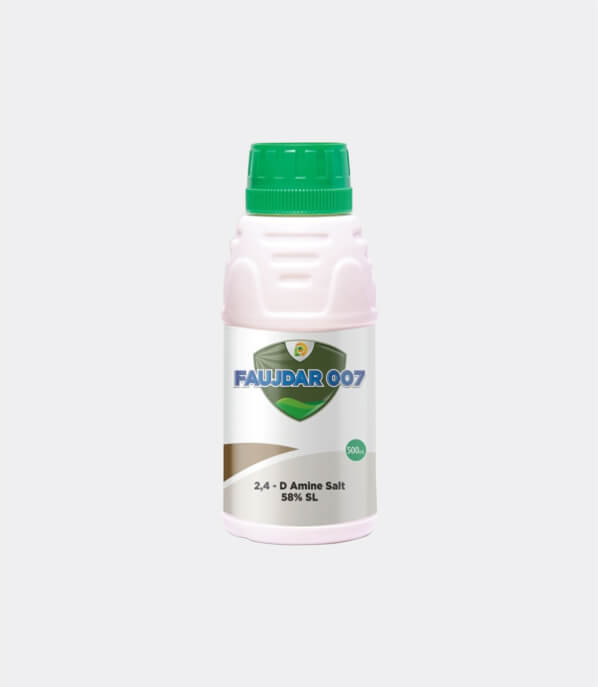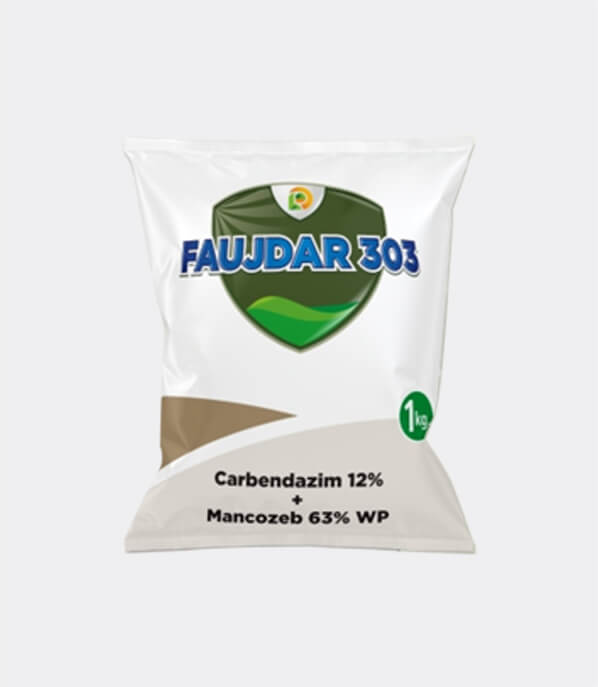
FAUJDAR-007
2, 4-D Amine salt 58% SL
- Faujdar-007 is recommended to control cyperus iria, trianthema spp., tridax procumbens, Digera arvensis of sorghum. Triathema monogyna, Amaranthus spp., etc of miaze. Chenopodium album, Asphodelus tenuefolius, fumaria spp., melilotus alba of wheat.
- Also control Eichhornia crassipes as aquatic weeds of potato, sugarcane and non crop area.

FAUJDAR-011
Pretilachlor 50% EC
- Faujdar-011 is a broad spectrum rice herbicide which is mainly used for pre-emergence to early post-emergence of weeds.
- It controls a variety of weeds effectively. The major targets of this herbicide are annual grasses, sedges, and broad level weeds.
- This herbicide has a specific working phenomenon where it suppresses the growth of weeds by reducing the cell division.
- Faujdar-011 does not harm crops by leaving yellowing or stunting effects. On other hand it renders a greening effect to the crop.

FAUJDAR-099
Oxyflourfen 23.5% EC
- Faujdar-099 is a herbicide of the diphenyl-ether group used for selective weed control in a wide range of fruit trees, vegetables, field crops, ornamentals, forestry, sugarcane and non-crop areas.
- Faujdar-099 controls a wide spectrum of annual broad leaf and grass weeds.
- Faujdar-099 is used in pre-plant, pre-emergence and post-emergence applications.
- Faujdar-099 has prolonged residual activity and shows negligible leaching. Minimal rain or irrigation is necessary to activate the residual effect.
- It can be used with spendiko.
- Faujdar-099 is a selective herbicide.
- It controls many annual broad-leaf weeds, some grasses and provides suppression of some perennials.
- Low concern for persistence or carry-over in soil (Half-life in soil is approximately 30-40 days).
- It is strongly adsorbed to soil and is not readily desorbed.
- It has no known cases of weed resistance to date.

FAUJDAR-101
Glyphosate 41% SL
- Glyphosate is an aminophosphonic analogue of the natural amino acid glycine.
- Glyphosate (N-(phosphonomethyl)glycine) is a broad-spectrum systemic herbicide and an organophosphorus compound, specifically a phosphonate.
- Glyphosate is absorbed through foliage, and minimally through roots, It is used to kill weeds, especially annual broadleaf weeds and grasses that compete with crops.
- While Weed growth stops within hours of application it might takes few days for the leaves to start to turn yellow.

FAUJDAR-108
Ammonium Salt of Glyphosate 71% SG
- Faujdar-108 is again an aminophosphonic analogue of the natural amino acid glycine in soluble granules formulation.
- Due to Faujdar-108 non-selective action it kills all types of weeds.
- Faujdar-108 stops a specific enzyme, EPSP synthase, which is required for plant growth and this enzyme is found only in plants and many bacteria.
- Faujdar-108 does not affect the germination of ensuing crops and any crop can be grown after its application.

Carbendazim 12% + Mancozeb 63% WP
Ammonium Salt of Glyphosate 71% SG
- Faujdar-303 is a scientific combination of Mancozeb which is a contact fungicide of dithicarbamate group and carbendazim, a systemic fungicide of Benzimidazole carbamate group.
- Faujdar-303 effectively controls the fungal diseases like Rice blast by its systemic and contact action.
- Faujdar-303 helps in increasing the production of field crops and vegetables.
- Faujdar-303 is a suitable fungicide for Integrated Pest Management (IPM).
- Faujdar-303 is compatible with commonly used insecticides and fungicides.

FAUJDAR-786
Pendimethalin 30% EC
- Faujdar-786 is an herbicide of the dinitroaniline class used in premergence and post-emergence applications to control annual grasses and certain broad leaf weeds.
- Faujdar-786 acts both pre-emergence, that is before weed seedlings have emerged, and early post-emergence.
- Faujdar-786 inhibits root and shoot growth. It controls the weed population and prevents weeds from emerging.
- Its primary mode of action is to prevent plant cell division and elongation in susceptible species.
- Faujdar-786 protects crops like wheat, corn, soybeans potatoes, cabbage, peas, carrots and asparagus from unwanted plants.